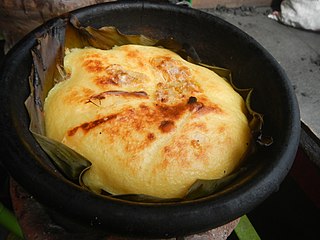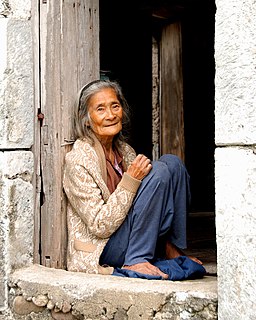
Luzon is the largest and most populous island in the Philippines. It is ranked 15th largest in the world by land area. Located in the northern portion of the archipelago, it is the economic and political center of the nation, being home to the country's capital city, Manila, as well as Quezon City, the country's most populous city. With a population of 53 million as of 2015, it contains 52.5% of the country's total population and is the fourth most populous island in the world.

Ilocos Sur is a province in the Philippines located in the Ilocos Region in Luzon. Its capital is the city of Vigan, located on the mouth of the Mestizo River. Ilocos Sur is bordered by Ilocos Norte and Abra to the north, Mountain Province to the east, La Union and Benguet to the south and the South China Sea to the west.

La Union, officially the Province of La Union, is a province in the Philippines located in the Ilocos Region in the Island of Luzon. Its capital is the City of San Fernando, which also serves as the regional center of the Ilocos Region.

Batanes is an archipelagic province in the Philippines, administratively part of the Cagayan Valley region. It is the northernmost province in the country, and also the smallest, both in population and land area. Its capital is Basco located on the island of Batan.

Ilocos Region is an administrative region of the Philippines, designated as Region I, occupying the northwestern section of Luzon. It is bordered by the Cordillera Administrative Region to the east, the Cagayan Valley to the northeast and southeast, and the Central Luzon to the south. To the west lies the South China Sea.

The Spanish influence on Filipino culture has been profound, having originated from the Spanish East Indies. A variety of aspects of the customs and traditions in the Philippines today can be traced back to this influence.

Japanese settlement in the Philippines or Japanese Filipino, refers to the branch of the Japanese diaspora having historical contact with and having established themselves in what is now the Philippines. This also refers to Filipino citizens of either pure or mixed Japanese descent currently residing in the country, the latter a result of intermarriages between the Japanese and local populations.

Pangasinan, officially the Province of Pangasinan is a province in the Philippines located in the Ilocos Region of Luzon. Its capital is Lingayen. Pangasinan is on the western area of the island of Luzon along Lingayen Gulf and the South China Sea. It has a total land area of 5,451.01 square kilometres (2,104.65 sq mi). According to the 2020 census, it has a population of 3,163,190 people. The official number of registered voters in Pangasinan is 1,651,814. The western portion of the province is part of the homeland of the Sambal people, while the central and eastern portions are the homeland of the Pangasinan people. Due to ethnic migration, Ilocano people have settled in some areas of the province.

Filipinos are the people who are native to or citizens of the country the Philippines. The majority of Filipinos today comes from various Austronesian ethnolinguistic groups. Currently, there are more than 185 ethnolinguistic groups in the Philippines; each with its own language, identity, culture and history.

The Philippines is inhabited by more than 175 ethnolinguistic nations, the majority of whose languages are Austronesian in origin. Many of these nations converted to Christianity, particularly the lowland-coastal nations, and adopted foreign elements of culture. Ethnolinguistic nations include the Ilocano, Ivatan, Pangasinan, Kapampangan, Tagalog, Bicolano, Visayans, Zamboangueño, Subanon, and more.

The Ilocanos, Ilokanos, or Iloko people are the third largest Filipino ethnolinguistic group and mostly reside within the Ilocos Region in the northwestern seaboard of Luzon, Philippines, speaking Ilocano.

Bibingka is a type of baked rice cake from the Philippines. It is usually eaten for breakfast, especially during the Christmas season. It is traditionally cooked in clay pots lined with leaves. It is a subtype of kakanin in Philippine cuisine. Bibingka is also found in East Timor and Christian communities in eastern Indonesia.

Tapai, is a traditional fermented preparation of rice or other starchy foods, and is found throughout much of Southeast Asia, especially in Austronesian cultures, and parts of East Asia. It refers to both the alcoholic paste and the alcoholic beverage derived from it. It has a sweet or sour taste and can be eaten as is, as ingredients for traditional recipes, or fermented further to make rice wine. Tapai is traditionally made with white rice or glutinous rice, but can also be made from a variety of carbohydrate sources, including cassava and potatoes. Fermentation is performed by a variety of moulds including Aspergillus oryzae, Rhizopus oryzae, Amylomyces rouxii or Mucor species, and yeasts including Saccharomyces cerevisiae, and Saccharomycopsis fibuliger, Endomycopsis burtonii and others, along with bacteria.

The Ivatan people are an Austronesian ethnolinguistic group native to the Batanes and Babuyan Islands of the northernmost Philippines. They are genetically closely-related to other ethnic groups in Northern Luzon, but also share close linguistic and cultural affinities to the Tao people of Orchid Island in Taiwan.

The Manunggul Jar is a secondary burial jar excavated from a Neolithic burial site in the Manunggul cave of the Tabon Caves at Lipuun Point in Palawan, Philippines. It dates from 890–710 B.C. and the two prominent figures at the top handle of its cover represent the journey of the soul to the afterlife.

The cultural achievements of pre-colonial Philippines include those covered by the prehistory and the early history (900–1521) of the Philippine archipelago's inhabitants, the pre-colonial forebears of today's Filipino people. Among the cultural achievements of the native people's belief systems, and culture in general, that are notable in many ethnic societies, range from agriculture, societal and environmental concepts, spiritual beliefs, up to advances in technology, science, and the arts.

The prehistory of the Philippines covers the events prior to the written history of what is now the Philippines. The current demarcation between this period and the Early history of the Philippines is April 21, 900, which is the equivalent on the Proleptic Gregorian calendar for the date indicated on the Laguna Copperplate Inscription—the earliest known surviving written record to come from the Philippines. This period saw the immense change that took hold of the archipelago from Stone Age cultures in the fourth century, continuing on with the gradual widening of trade until 900 and the first surviving written records.

Tapuy, also spelled tapuey or tapey, is a rice wine produced in the Philippines. It is a traditional beverage originated from Banaue and the Mountain Province, where it is used for important occasions such as weddings, rice harvesting ceremonies, fiestas and cultural fairs. It is produced from either pure glutinous rice or a combination of glutinous and non-glutinous rice together with onuad roots, ginger extract, and a powdered starter culture locally known as bubod. Tapuy is an Ilocano name. The wine is more commonly called baya or bayah in Igorot languages.

Burong isda is a Filipino dish consisting of cooked rice and raw filleted fish fermented with salt and angkak for around a week. The dish is common in central Luzon, most notably in the province of Pampanga. Angkak may also be omitted, especially in western central Luzon, resulting in a white-colored version. Burong isda variants are usually named after the fish they were made with; e.g. burong bangus for burong isda made with bangus (milkfish). Shrimp versions of the dish are known as burong hipon or balao-balao. Burong isda is very similar to other fermented fish and rice dishes of Asia, including narezushi of Japanese cuisine and pla ra of Thai cuisine. All of these dishes rely on lactic acid fermentation to preserve the food.
Philippine ceramics are mostly earthenware, pottery that has not been fired to the point of vitrification. Other types of pottery like tradeware and stoneware have been fired at high enough temperatures to vitrify. Earthenware Ceramics in the Philippines are mainly differentiated from Tradeware and stonewares by the materials used during the process and the temperature at which they are fired. Additionally, earthenware and stoneware pottery can generally be referred to as ceramics that are made with local materials, while tradeware ceramics can generally be referred to as ceramics that are made with non-local materials.



























